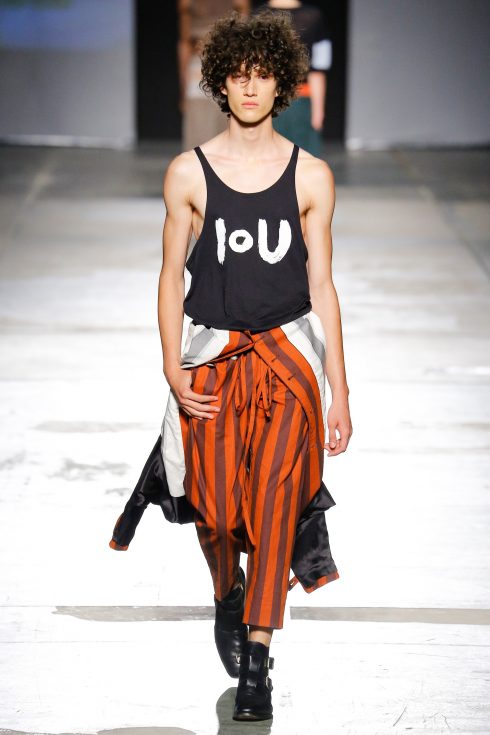
Vivienne Westwood Spring 2017 Menswear
Boundaries mean little to Dame Vivienne Westwood. Perhaps because she transgressed so many in the ’70s. This is, after all, a woman who habitually wore a see-through rubber body suit—dubbed the “Rubber Johnny,” after a British prophylactic colloquialism and due to its translucent pink material—and who sold T-shirts scrawled with obscenities, erect penises, and the like. So while today’s show was subtitled “Man”, the show itself was unisex, with men and women modeling, often wearing clothes that could more readily belong to the opposite sex. Female models were dressed in wide, purposefully sloppy tailoring; male models as often as not wore skirts or dresses. Gender gap? What gender gap? The male models, oddly, looked oddly appealing in the skinny knit dresses. Nevertheless, you knew which side of the closet these pieces would probably wind up on, for all but the most die-hard Westwood fans.
The only boundary Westwood seems keen to reinforce, strangely, is a certain distance from the designs. Her Gold Label womenswear was last season rechristened “Andreas Kronthaler for Vivienne Westwood,” an outward acknowledgement of an interior dynamic that sees Kronthaler leading the design team, while Westwood focuses on political causes close to her heart. And while those political causes used to influence the clothes, and continue to be broadcast loudly during the publicity of her fashion shows, these days the two sides of that Westwood dynamic seem disparate, disconnected.
More’s the pity. Because although Westwood’s politics could often overpower the fashion she designed—both for the last 25 or so years in partnership with Kronthaler, and even way back when it was just Westwood herself at the design table—they often empowered them. Eleven years ago, she splashed the word “Propaganda” across her clothes in the hopes, she once told me, of politicizing youth. Those pieces have now rolled into the cannon of a Westwood classic, and even if their original intention—resisting the propaganda of the contemporary age through art and culture—is occasionally lost, they’re recognized as a counter-culture statement. They’re worn by people young and old.
Westwood today made an impassioned video plea for the release of Julian Assange, who, she asserts, has done no wrong. Her point deserves to be heard—but is a fashion show the right place and, more importantly, does it have the right audience if one wishes to affect real and lasting sociopolitical changes? Westwood’s messages in the past had validity in that unusual arena because they informed every facet of the clothes she and Kronthaler created together. In dressing the world in her sartorial palimpsests, Westwood campaigned through clothing. It was a unique stance—one not really seen since Katharine Hamnett in the ’80s. It was sometimes heavy-handed, but it was always impassioned, heart-felt, and singular. The chewed-up and bog-washed clothes Kronthaler created looked very Westwood, in their muddy colors and arresting disproportion. But you wouldn’t have minded that message being more insistently stitched into every seam. That’s a Westwood trademark as important and instantly identifiable as pirate boots or bondage trousers.

.jpg)
.jpg)
.jpg)
.jpg)
.jpg)
.jpg)
.jpg)
.jpg)
.jpg)
.jpg)
.jpg)
.jpg)
.jpg)
.jpg)
.jpg)
.jpg)
.jpg)
.jpg)
.jpg)
.jpg)
-560x600.jpg)

